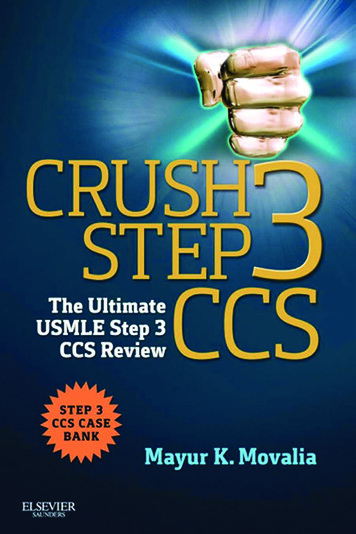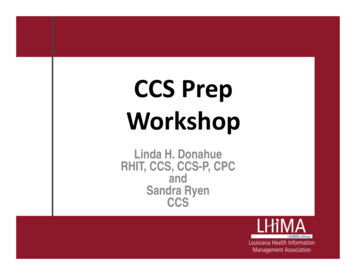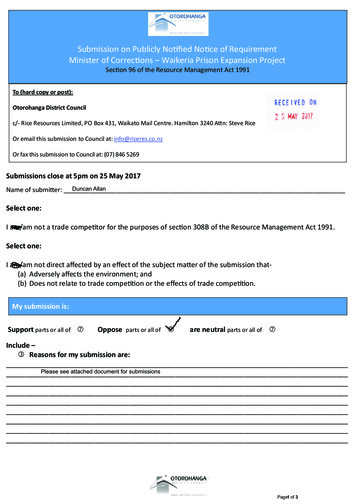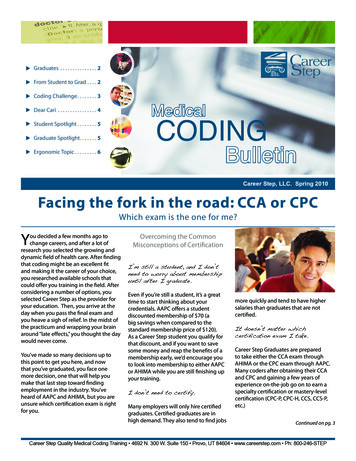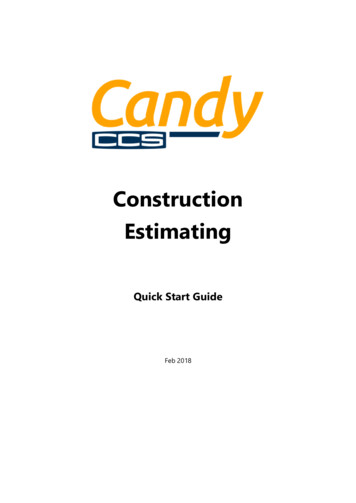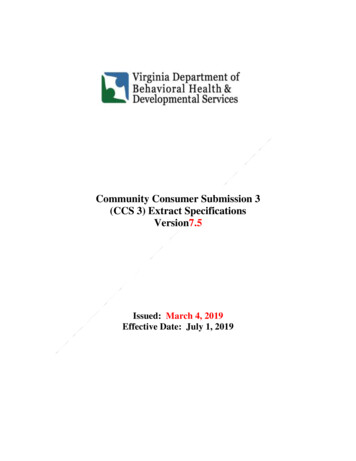
Transcription
Community Consumer Submission 3(CCS 3) Extract SpecificationsVersion7.5Issued: March 4, 2019Effective Date: July 1, 2019
Revision HistoryDateVersionAuthorDescription7/1/20091.0P. GildingOriginal for Fiscal Year (FY) 20107/1/20137.1P. GildingUpdate for FY 20141/1/20147.1 Rev1P. GildingRevision for Mid-Year Release, FY 20151/1/20147.2P. GildingConsolidated for FY 20151/1/20157.3P. GildingFirst update for FY 20167/1/20157.3.1P. GildingSecond update for FY 20167/1/20167.3.2P GildingFirst update for FY 20177/1/20177.3.3P. GildingUpdate for FY 20187/1/20187.4P. GildingFirst Update for FY 201810/30/20187.4.1P. GildingSecond Update for FY 20183/4/20197.5S. A. Elmore, PhDUpdate for FY 2020 implementation
Community Consumer Submission 3 Extract Specifications: Version 7.5Table of ContentsPURPOSE AND SCOPE OF CCS 3PurposeScopeDEFINITIONS AND GUIDANCE FOR CCS REPORTINGDate ProvidedFrom/Through DateEpisode of Care DescriptionType of Care DescriptionEpisode of Care and Program AreaType of Care and Consumer Designation Codes (CDCs)EXTRACT FILESSUBMISSION PROCEDURES AND PROCESSESCCS Extracts Submitted for a New Fiscal YearAPPENDIX A: EXTRACT LOOKUP TABLESAPPENDIX B: CCS 3 EXTRACT FILE LAYOUTSAPPENDIX C: CCS 3 EXTRACT DATA ELEMENT DEFINITIONSCCS 3 DATA ELEMENT NAMES, DEFINITIONS, AND DESCRIPTIONSAPPENDIX D: DATA COLLECTION MATRIXAdmission to or Discharge from a Program Area (Type of Care event)Data Element and Program Area Cross-Reference TableAPPENDIX E: BUSINESS RULESBlanks (NULL)Not Applicable (96)Unknown (97: Asked but not answered)Not Collected (98: Not asked)APPENDIX F: FY 2020 VALID CCS 3 SERVICES TABLE FOR DATA ELEMENT 10APPENDIX G: TAXONOMY DEFINITIONS OF OUTPATIENT AND MEDICALSERVICESAPPENDIX H: OUTCOME MEASURE DEFINITIONS AND IMPLEMENTATIONGUIDANCEAPPENDIX I: CCS 3 USER ACCEPTANCE TESTING (UAT) PROCESSVersion 7.5 Issued 3-4-20191.Effective Date: 65676874
Community Consumer Submission 3 Extract Specifications: Version 7.5Purpose and Scope of CCS 3PurposeThe Department of Behavioral Health and Developmental Services (Department) developed theseCCS 3 Extract Specifications in collaboration with the Data Management Committee (DMC) of theVirginia Association of Community Services Boards (VACSB). The Department, in partnershipwith community services boards and the behavioral health authority (CSBs), uses the CommunityConsumer Submission (CCS) to comply with federal and state reporting requirements, includingthose in the federal substance abuse Treatment Episode Data Set (TEDS) and federal mental health(MH) and substance abuse block grants (MHBG/SABG); to submit data to state funding sources,including the General Assembly and Department of Planning and Budget; and to produce data aboutthe performance of the public mental health, developmental, and substance use disorder (SUD)services system. State and federal policymakers and decision-makers and many others use this CCSdata. The CCS provides data for comparisons of and trends in the numbers and characteristics ofindividuals receiving direct and contracted mental health, developmental, and substance usedisorder services from CSBs. Version 7.5 incorporates all revisions made to the Specificationssince Version 7, issued in 2009, and shows changes from Version 7.4.1 in red text.This document provides CCS 3 extract specifications to CSB information technology (IT) staff andvendors for reporting data about individuals and services through the Department’s CCS process.The principal audiences for this document are Department and CSB staff and CSB IT vendorsinvolved with collecting, reporting, and using data about individuals receiving services and thedirect or contracted services they receive from CSBs. CSB staff and IT vendors responsible forimplementing CCS 3 should review and must adhere to these Extract Specifications and the currentCCS 3 Business Rules, incorporated by reference into these Specifications and distributed with thecurrent CCS 3 application release. These rules establish acceptable parameters and validationcriteria for CCS 3 data elements and describe error-checking routines and operations. CSB IT staffand vendors also should review and must adhere to applicable parts of the current core servicestaxonomy, such as service and service unit definitions. The extract specifications are incorporatedinto and made a part of the current community services performance contract by reference.Core Services Taxonomy 7.2 and the FY 2010 Community Services Performance Contracteliminated requirements for reporting data in Community Automated Reporting System (CARS)reports about the numbers of individuals who received services and units of service they receivedbecause this data is now reported through the CCS. Eliminating redundant reporting requirementsreduced data errors and improved the completeness and accuracy of CCS data.ScopeThrough CCS 3 Version 7.5, the Department collects 84 required data elements from CSBs aboutservices and individuals in a secure single submission to the Department. CCS software does notrequire any additional data entry. Instead, CSBs extract data from their local information systemsor electronic health records (EHRs) by exporting the data into the CCS application for the creationand transmission of required files.The CCS is a compilation of demographic, clinical, and descriptive data about individuals withmental illnesses, substance use disorders, developmental disabilities, or co-occurring disorders anddata about the mental health, developmental, substance use disorder, emergency, and ancillaryservices they receive. In this document, mental illnesses, substance use disorders, anddevelopmental disabilities refer to conditions that individuals experience, while mental health,Version 7.5 Issued 3-4-20192.Effective Date: 07/01/2019
Community Consumer Submission 3 Extract Specifications: Version 7.5substance use disorder, and developmental refer respectively to the services that address thoseconditions. For the CCS to produce valid data, all CSBs must submit complete and accurate datausing the same formats and definitions. This document provides definitions of the informationneeded to produce the standard data files and the extract specifications that are required for CSBs toreport individual level data through the CCS. This document also describes the process ofsubmitting CCS files to the Department.Definitions and Guidance for CCS ReportingThe core services taxonomy is used, per State Board Policy 1021 (SYS) 87-9, to classify, describe,and measure services delivered by all CSBs directly or through contracts with other providers. Thetaxonomy defines many of the terms used in these Specifications, definitions in the currenttaxonomy, available at http://www.dbhds.virginia.gov under Office of Management ServicesIndividual Receiving ServicesSection 37.2-100 of the Code of Virginia defines an individual receiving service(s) or individual asa current direct recipient of public or private mental health, developmental, or substance usedisorder treatment, rehabilitation, or habilitation services. This definition includes the terms“consumer,” “patient,” “resident,” “recipient,” or “client” used in previous statutes, regulations,policies, and other documents. This version of the CCS 3 Extract Specifications uses individual orindividual receiving services, unless the context requires the use of consumer (e.g., the CommunityConsumer Submission). CCS 3 does not collect or report information about individuals receivingsubstance use disorder prevention or Part C infant and toddler early intervention services; otherreporting mechanisms collect this information.Information about all individuals receiving any direct or contracted CSB services defined in thecore services taxonomy, except for substance use disorder prevention services, Mental Health FirstAid and suicide prevention services, or infant and toddler early intervention (Part C) services, mustbe reported in the CCS. Since the CARS no longer reports data about individuals receivingservices, there will be no other source for this data except the CCS. CSB information system orEHR extracts that generate data for the Department’s CCS 3 extract must include information inConsumer.txt files only about individuals who have an open record or have been admitted to aprogram area and have received a valid service or have been discharged from a program area withor without receiving a service during the fiscal year (active individuals). CSBs must not includeother individuals in Consumer.txt files.Z-Consumer:An individual receiving service(s) is identified in the CCS by a hashed social security number(SSN) and a consumer identification number (ConsumerId). However, when a specific individual isnot identified as receiving a service, a z-consumer code is used in the Service.txt file. The letter z(lower or upper case) in the first position of the ConsumerId field (data element 7) identifies this zconsumer code. Any value in that field that begins with the letter Z will be considered anunidentified individual, regardless of the characters that follow it. CSBs must not use a z-consumercode to report services received by groups of individuals; a separate Service.txt record must besubmitted for each individual receiving the service. The core services taxonomy contains moredetailed information about service hours reported for z-consumers.Version 7.5 Issued 3-4-20193.Effective Date: 07/01/2019
Community Consumer Submission 3 Extract Specifications: Version 7.5Program AreaThe core services taxonomy defines program area as the general classification of service activitiesfor one of the following defined conditions: mental illnesses, developmental disabilities, orsubstance use disorders. The three program areas in the public services system are mental health,developmental, and substance use disorder services, ProgramAreaId codes 100, 200, and 300. CCS3 also includes the 400 code as a pseudo ProgramAreaId to identify emergency or ancillary services(services outside of a program area). CSBs must use code 400 only in the Service.txt file, not in theTypeOfCare.txt file. CSBs must not admit or discharge individuals to or from the 400 code.Service Codes and UnitsThe core services taxonomy defines services. CCS 3 identifies a service by a program area orpseudo program area code and a core services category or subcategory code (service code) with acorresponding unit of measure. This includes all services received by individuals from the CSBdirectly and from CSB contractors. All contracted services included in performance contracts andCARS reports must be included in CCS 3 service files. CCS 3 reports actual service delivery; itdoes not collect or report estimated units of services. The taxonomy identifies these service codesand defines their corresponding units; refer to it for complete definitions of service units. The units(data element 10) field captures and reports the number of units of services received by individuals.CCS 3 reports the following types of service units in this field: service hours, bed days, day supportservice hours, and days of service. Appendix F lists valid program area and service codes.Consumer-Run ServicesConsumer-Run Services (730) are not traditional clinical or treatment services, and the nature andcontext of these programs emphasize individual empowerment and provide support in an informalsetting. See the definition for these services in the current taxonomy. No Service.txt records aresubmitted for this service, and no Consumer.txt records are submitted for individuals who receiveonly consumer-run services. CSBs providing this service gather and report information about it andthe individuals receiving it separately in the CARS management report, rather than in CCS.Service HoursA service hour is a continuous period measured in fractions or multiples of an hour during which anindividual or a family member, authorized representative, care giver, health care provider, orsignificant other through in-person or electronic (audio and video or telephonic) contact on behalfof the individual receiving services or a group of individuals participates in or benefits from thereceipt of services. This also includes significant electronic contact with individuals receivingservices and activities that are reimbursable by third party payers. Service hours measure theamounts of services received by or on behalf of individuals or groups of individuals. Service hoursare reported in the CCS Service file only for the following core services: Emergency services,Motivational treatment services,Consumer monitoring services,Assessment and evaluation services,Early intervention services,Outpatient services,Medical services,Version 7.5 Issued 3-4-2019 Medication assisted treatment,Assertive community treatment,Case management services,Individual supported employment,Supportive residential services, andMental health or developmental preventionservices.4.Effective Date: 07/01/2019
Community Consumer Submission 3 Extract Specifications: Version 7.5 Intensive outpatient services,CSBs must not report service hours in the CCS for any other services. CSBs report substance usedisorder prevention services and Mental Health First Aid and suicide prevention service hoursthrough the Department’s contracted prevention services data system and must not include them inthe CCS. CSBs collect service hours for services listed above that are not received by or associateddirectly with individuals or groups of individuals using the z-consumer ConsumerId code and reportthem as NC services. For NC services, if the ConsumerId in the Service file does not start with a zor the service is not listed above, an error will occur. Refer to Appendix F for more information.Service DatesCCS 3 requires that specific dates be identified for a time period during which services are receivedby an individual. Because CCS 3 reports services with specific dates, they are not aggregated. Twodate fields are available. The first date is the date that the service started (service from date); thesecond is the date that the service ended (service through date). If a service starts and ends on thesame date, then the values of both fields would be the same. Allowing for a separate through dateenables reporting services that might be reported more efficiently over a longer period than a singleday. The through date is not used to calculate units of service; units of service should be those thatare actually received, or those service hours provided for z-consumers, during the time period. CCS3 does not do any calculations involving from and through dates to calculate the units of service.Tables 1 and 2 show the use of the two fields varies by service code.Date ProvidedThe service codes in this reporting category in Tables 1 and 2 are reported for the specific dateusing the ServiceFromDate field. The value of the ServiceFromDate must also be copied into theServiceThroughDate field in the extract so that the two fields show that the service starts and endson the same date. For example, if an individual received three hours of outpatient services onMarch 1, 2019, the CSB would report a single service record for three hours of outpatient serviceswith a ServiceFromDate of 03012019 and a ServiceThroughDate of 03012019.Data element 106 (eff. 7/1/18), Service Modality, requires each service hour unit of service (coreservice codes 100, 310, 312, 313, 318, 320, 335, 350, 390, 460, 581, 610, 620, and 720) beidentified as face-to-face or non-face-to-face. Thus, for services in Tables 1 and 2 where serviceunits are reported “On that date,” CSBs can aggregate multiple service units of the same type offace-to-face service provided on the same day into a single face-to-face service record, but theymust send a separate face-to-face service record for each day on which these services are provided.Similarly, CSBs can aggregate multiple service units of the same type of non-face-to-face serviceprovided on the same day into a single non-face-to-face service record, but they must send aseparate non-face-to-face service record for each day on which these services are provided.Alternatively, CSBs can send a separate service record for each face-to-face or non-face-to-faceservice unit provided on the same day. CSBs cannot submit service hour service records thataggregate service units for multiple days in a month.With the addition of this new Service Modality data element, (Version 7.4) eliminates all of theface-to-face and non-face-to-face codes in data element 64, Service Subtype, for developmentalcase management services. Now, data element 64 includes only quarterly case management ISPreviews and annual case management ISP meetings as service subtypes for developmental casemanagement services. CSBs must use Not Applicable (code 96) for any developmental caseVersion 7.5 Issued 3-4-20195.Effective Date: 07/01/2019
Community Consumer Submission 3 Extract Specifications: Version 7.5management services that do not involve quarterly case management ISP reviews or annual casemanagement ISP meetings. Refer to data element 64 for additional information.From/Through DateThe service records in this reporting category in Tables 1 and 2 will have separate values in eachdate field. The ServiceFromDate field identifies the day the provision or receipt of service begins,and the ServiceThroughDate field identifies the day the provision or receipt of service ends. Thesefields are inclusive; they include services provided on those days. A day represents a normal 24hour time period from 12:00 a.m. to 12:00 a.m. (midnight to midnight). CCS 3 Business Rulesabout service dates include the following requirements. For services provided during an admission to a program area, the ServiceFromDate must be adate equal to or greater than the TypeOfCareFromDate, and the ServiceThroughDate must be adate equal to or less than the TypeOfCareThroughDate. If the TypeOfCareThroughDate isblank, the ServiceThroughDate must be a date less than or equal to the end of the currentreporting month. In other words, the dates of the service must fall within the dates of thecorresponding type of care for the program area. The ServiceThroughDate must be a date greater than or equal to the ServiceFromDate, unless itis blank. The ServiceThroughDate can be blank only if the CSB is technically unable to providethe ServiceThroughDate. Service records cannot span multiple months. If a service spans multiple months, then a CSBmust create a separate service record at the start of each month that the service is provided. TheServiceThroughDate cannot be greater than the last day of the reporting month.For example, if a CSB began serving an individual in a group home on December 15, 2018, and theindividual was still receiving services at the end of the month, the extract for December would havea service record that showed 17 bed days of intensive residential services (service code 521) for the15th through 31st. The ServiceFromDate would be 12152018; the ServiceThroughDate would be12312018. If the individual was still receiving services in January, but left the group home onJanuary 14, 2019, there would be a service record in January with a ServiceFromDate of 01012019,a ServiceThroughDate of 01142019, and service units of 14 bed days (the 1st through14th). If thissame individual ended his or her intensive residential services on December 22, 2018, then therewould be one service record extracted for December showing a ServiceFromDate of 12152018, aServiceThroughDate of 12222018, and service units of eight bed days (the 15th through 22nd).Version 7.5 Issued 3-4-20196.Effective Date: 07/01/2019
Community Consumer Submission 3 Extract Specifications: Version 7.5Service Date Reporting CategoriesThe service codes and their corresponding reporting categories are broken out in the followingtables in the order in which they are listed in the current core services taxonomy.Table 1: Emergency and Ancillary ServicesReportingServiceCodeCore Service NameReported Units ProvidedCategory100 Emergency ServicesOn that dateDate providedAncillary Services318 Motivational Treatment ServicesOn that dateDate provided390 Consumer Monitoring ServicesOn that dateDate provided620 Early Intervention ServicesOn that dateDate provided720 Assessment and Evaluation ServicesOn that dateDate providedTable 2: Services Available at Admission to a Program AreaServiceReportingCodeCategoryCore Service NameReported Units ProvidedAcute Psychiatric or Substance Use250Over that period of time From/through dateDisorder (SUD) Inpatient ServicesCommunity-Based SUD Medical260Over that period of time From/through dateDetoxification Inpatient Services310 Outpatient ServicesOn that dateDate provided312 Medical ServicesOn that dateDate provided313 Intensive Outpatient ServicesOn that dateDate provided320 Case Management ServicesOn that dateDate provided335 Medication Assisted TreatmentOn that dateDate provided350 Assertive Community TreatmentOn that dateDate provided410 Day Treatment or Partial Hospitalization Over that period of time From/through date420 Ambulatory Crisis Stabilization Services Over that period of time From/through date425 Rehabilitation or HabilitationOver that period of time From/through date430 Sheltered EmploymentOver that period of time From/through date460 Individual Supported EmploymentOn that dateDate provided465 Group Supported EmploymentOver that period of time From/through date501 Highly Intensive Residential ServicesOver that period of time From/through date510 Residential Crisis Stabilization ServicesOver that period of time From/through date521 Intensive Residential ServicesOver that period of time From/through date551 Supervised Residential ServicesOver that period of time From/through date581 Supportive Residential ServicesOn that dateDate provided610 MH or Developmental Prevention Services On that dateDate providedVersion 7.5 Issued 3-4-20197.Effective Date: 07/01/2019
Community Consumer Submission 3 Extract Specifications: Version 7.5Type of Care and Episode of CareEpisode of Care DescriptionThe core services taxonomy defines an episode of care as all of the services provided to anindividual to address an identified condition or support need over a continuous period of timebetween an admission and a discharge. An episode of care begins with an admission to a programarea, and it ends with the discharge from that program area. An episode of care may consist of asingle face-to-face encounter or multiple services provided through one or more programs. CSBsmust not admit an individual to emergency or ancillary services; those services are outside of anepisode of care. If an individual has received his or her last service but has not yet been dischargedfrom a program area, and he or she returns for services in that program area within 90 days, theindividual is not readmitted, since he or she has not been discharged; the individual is merelyaccepted into that program area for the needed services.Type of Care DescriptionIn CCS 3, type of care is used to represent a time period between a beginning and an ending point intime or a from date and a through date. A type of care in CCS 3 includes an episode of care, whichis just one example of a type of care. A type of care is any time period with the followingcharacteristics. It is bounded by a starting point and an ending point, both of which are specific dates. It represents a point in time at which to view the status of the individual receiving services. It is a marker after which the data input requirements in the CCS change. These markersdetermine what specific pieces of data are to be reported, as documented in Appendix D, toidentify “When is Data Collected”?The TypeOfCare file in CCS 3 represents a type of care. The TypeOfCare file includes records thatrepresent: an episode of care (i.e., an admission to and discharge from a program area), a consumer designation code indicating that an individual is participating in a special project,program, or initiative indicated by a 900 code, or any other type of care that meets any of the three characteristics above.Episode of Care and Program AreaIn CCS 3, an episode of care in any of the three program areas represents an admission to anddischarge from that program area. In CCS 3, there are no admissions to or discharges from a CSBor a particular service, only to or from a program area. Individuals can have an unlimited numberof episodes of care, although at any given point in time they must be in only one episode of care forany one program area at any given CSB. A current episode of care is one in which the through dateis null. A previous episode of care is one in which the through date is less than or equal to thecurrent date or last day of the extract month. For example, if an individual is receiving treatmentfor co-occurring mental illnesses and substance use disorders, he or she will have one mental healthepisode of care and one substance use disorder episode of care and may have any number ofprevious episodes of care.Version 7.5 Issued 3-4-20198.Effective Date: 07/01/2019
Community Consumer Submission 3 Extract Specifications: Version 7.5Episodes of care in different program areas can overlap; there is no requirement that an episode ofcare end in one program area before another episode of care begins in a different program area.However, episodes of care cannot overlap in the same program area; CSBs must not submitTypeOfCare records for more than one episode of care in the same program area at the same time.Admission to a program area admits an individual to any of the services in that program area; thereis no separate admission to a service or individual program within that program area.Type of Care and Consumer Designation Codes (CDCs)The core services taxonomy establishes consumer designation codes to identify individuals whoreceive services in specific initiatives or projects. These codes are not service codes per se, like 310is the core services code for outpatient services; instead, they reflect a particular status of thoseindividuals. The core services taxonomy includes the following consumer designation codes:905 - Mental Health Mandatory Outpatient Treatment (MOT) Orders,910 - Discharge Assistance Program (DAP),915 - Mental Health Child and Adolescent Services Initiative,916 - Mental Health Services for Children and Adolescents in Juvenile Detention Centers,918 - Program of Assertive Community Treatment (PACT),919 - Projects for Assistance in Transition from Homelessness (PATH),920 - Developmental Disability (DD) Home and Community-Based Waiver Services (HCBS) –Medicaid funded923 – Developmental Disability Enhanced Case Management Services (DD-ECM)933 - Substance Use Disorder Medication Assisted Treatment, and935 - Substance Use Disorder Recovery Support Services.936 – Project LINK (if applicable to the specific CSB)CSBs must use consumer designation code (CDC) 920 only for individuals who have been admittedto the developmental services program area (200) and are receiving services under any of the threeMedicaid developmental disability (DD) waivers (Building Independence, Family and IndividualSupports, or Community Living) directly from a CSB, from other agencies or individuals contractedby the CSB where the CSB remains the provider for DMAS payment purposes, or from any otherprovider of Medicaid DD waiver services that is reimbursed directly by DMAS. If it provides DDwaiver services to an individual, the CSB must admit the individual to the developmental servicesprogram area (200), assign a 920 CDC, and report any DD waiver services it provides to theindividual directly or through contracts with other providers of DD waiver services. The CSBreports the DD waiver services in CCS 3 using the core services taxonomy crosswalk athttp://www.dbhds.virginia. gov, under the Offices tab, under Office of Management Services.These requirements apply to the CSB even if the individual is in a waiver slot assigned to a differentCSB. The CSB to which a waiver slot has been assigned and filled must admit the individual in theslot to the developmental services program area (200), assign a 920 CDC, and providedevelopmental case management services (320) to the individual directly or through a contract withanother developmental case management services provider. The CSB must do this whether or not itprovides any DD waiver services to the individual directly or through other agencies or individualscontracted by the CSB where the CSB remains the provider for DMAS payment purposes.The 923 CDC captures data about developmental enhanced case management (ECM) servicespreviously collected using data element 90 in the consumer.txt file. It indicates if an individual whoVersion 7.5 Issued 3-4-20199.Effective Date: 07/01/2019
Community Consumer Submission 3 Extract Specifications: Version 7.5is receiving Medicaid DD Waiver services meets the criteria for receiving ECM services. ECMmeans the individual receives at least one face-to-face visit monthly with no more than 40 daysbetween visits and at least one such visit every other month is in the individual’s place of residence.An individual who meets any of the following criteria must receive ECM services: receives services from providers that have conditional or provisional licenses from theDepartment, has more intensive behavioral or medical needs as defined by the Supports Intensity Scalecategory representing the highest level of risk,* has an interruption of services longer than 30 days, encounters the crisis system for a serious crisis or for multiple less serious crises within a threemonth period, has transitioned from a state training center within the previous 12 months, or resides in a congregate setting of five or more beds.** as identified in Cas
CCS 3 reports the following types of service units in this field: service hours, bed days, day support service hours, and days of service. Appendix F lists valid program area and service codes. Consumer-Run Services Consumer-Run Services (730) are not tradi


